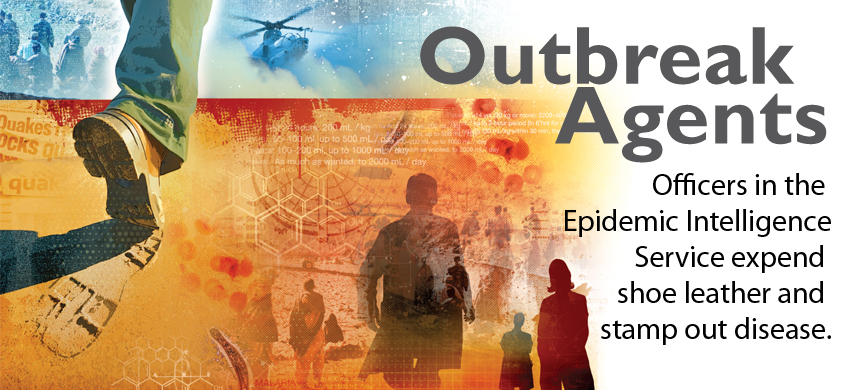
Since those early days, the ties between Johns Hopkins and the Service have held fast. About a dozen and a half current faculty members in the School of Medicine and the Bloomberg School are EIS alumni. And 28 of the 164 members of the EIS class of 2010 are graduates of Johns Hopkins or have worked there, the highest representation of any university in the program. The EIS is particularly popular for Bloomberg School graduates who want to ply their trade, sometimes before getting a PhD or an MD. “I still heartily recommend the EIS to Hopkins students,” says Guyer. “It’s very hard for our master’s students to transition into a public health career. EIS gives them a chance to do that and learn about what they’re getting into.”
That opportunity began with Langmuir. A dyslexic who read slowly, Alex Langmuir started his academic career by walking in the footsteps of his uncle, Irving Langmuir, a Nobel laureate in chemical physics. But young Alex couldn’t handle the advanced math while studying physics at Harvard and migrated to public health, eventually teaching at Harvard and Johns Hopkins. While a professor at Hopkins in 1949, Langmuir was hired as a chief epidemiologist by CDC to fight malaria. The then new CDC (which at the time stood for the Communicable Disease Center) was headquartered in Atlanta so its investigators and physicians could be closer to malaria cases in the southeastern United States. But Langmuir discovered that the malaria program was a farce. Scientists who had claimed there were live cases of the disease, often because there were no other explanations for certain patients’ bouts with fever, had kept $7 million in grant money rolling in annually. Through blood tests and additional surveillance, Langmuir discovered stateside malaria had been virtually eliminated by 1942.
Congress, among others, began to question the reasons for CDC’s existence. Around that same time, Langmuir was advocating an epidemiology agency that could snuff out a particularly grisly aspect of the Cold War: the possibility that pathogens could be used in biological warfare. Langmuir twisted the arms of his superiors at CDC to start a program that would monitor possible bioterrorism from the East. (One scenario had the Chinese floating a pathogen-filled balloon under the radar and over the United States, where a timer would release the germs, infecting thousands of people.) His initial proposal was thwarted by higher-ups at the
CDC, who were unsure of the need for a well-drilled group of “shoe-leather epidemiologists”—medical men who were equipped to search for diseases in populations. But Langmuir persevered. An outbreak of hemorrhagic fever among American troops serving in Korea won him the money he needed—even though the fever wasn’t due to bio-weapons, as was feared. The first class of EIS officers in 1951 consisted of 22 physicians and a sanitary engineer, taught by Langmuir and several Johns Hopkins colleagues. Although formed to guard against biological warfare, EIS had its purview expanded by Langmuir to include any local disease outbreak that states and localities needed help conquering.
Prior to the advent of the EIS, the National Institutes of Health would send people into the field to investigate outbreaks. “But that was totally dependent upon the interest of the researcher,” says D.A. Henderson, a Distinguished Service Professor at the Bloomberg School who served in the EIS from 1955 to 1957, and who was Langmuir’s right-hand man during those years and several thereafter. (Henderson would go on to lead the successful effort to eradicate smallpox worldwide.) “Alex’s idea was to have a presence that would help states with epidemics and to keep an eye on what was out there. This was a group that was immediately available and on-call. Getting out there and responding to emergencies was key.”
Langmuir’s brainchild is credited with invigorating the study and practice of public health, which had become a wallflower of a profession in the years after World War II, and for giving state health departments a new sense of purpose. “It wasn’t exactly a popular occupation back then,” says Mark Pendergrast, author of Inside the Outbreaks: The Elite Medical Detectives of the Epidemic Intelligence Service (Houghton Mifflin Harcourt, 2010). “People who worked at the state level were hardly go-getters when it came to investigating diseases. And there was a lot of thinking that treating infectious disease was on the way out because of the development of antibiotics and vaccines.”
The creation of the EIS may have done more than overcome that thinking. As the CDC searched for a mission to replace its apocryphal anti-malaria campaign, the EIS’s burgeoning reputation among state health commissioners and among public health professionals gave it a new sense of purpose. “If it had not been for Alex, there might not have been a CDC,” says Henderson. “It started out as a rinky-dink outfit that didn’t realize that malaria was done in the U.S. Now, countries around the world emulate it. Alex can take some credit for that.”
